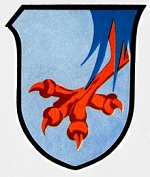Corgi AA36713 German Junkers Ju 88A-5 Medium-Bomber - F1+AS, 8./Kampfgeschwader 76, Orscha, Russia, December 1941 (1:72 Scale)
"Guns before butter. Guns will make us powerful; butter will only make us fat."
- Reichsmarschall Hermann Goering, Head of the German Luftwaffe
 The Luftwaffe's Junkers Ju 88 was a twin-engine, multi-role aircraft. Among the most versatile planes of the war, it was used as a bomber, close-support aircraft, nightfighter, torpedo bomber and reconnaissance aircraft. A solid aircraft with great performance, it went on to be one of the Luftwaffe's most versatile aircraft. It carried out almost every kind of mission ever imagined, even as a giant flying bomb. It was used in every theater, with many nations, including nations allied against Germany.
The Luftwaffe's Junkers Ju 88 was a twin-engine, multi-role aircraft. Among the most versatile planes of the war, it was used as a bomber, close-support aircraft, nightfighter, torpedo bomber and reconnaissance aircraft. A solid aircraft with great performance, it went on to be one of the Luftwaffe's most versatile aircraft. It carried out almost every kind of mission ever imagined, even as a giant flying bomb. It was used in every theater, with many nations, including nations allied against Germany.
The aircraft's first flight was made by Prototype Ju 88V-1, which bore the civil registration D-AQEN, on December 21st, 1936. When it first flew, it managed about 580 km/h (360 mph) and Hermann Goring was ecstatic. Finally it was something that could positively fulfill the promise of the Schnellbomber, a bomber so fast fighters could not catch it.
Unfortunately, by the time everyone had had their wish list added (including dive-bombing), the speed had dropped to around 450 km/h (280 mph). The draggy fuselage was modeled after its predecessor, the Dornier Do 17, but with fewer defensive guns because the belief still held that it could out-run fighters. It was also very, very late. Planned for 1938, it finally entered service the day the Germans invaded Poland, and then with only 12 aircraft. Production was painfully slow, and problems with such an advanced machine kept cropping up. The Ju 88C series of heavy fighter was also created very early in 1940, but kept secret from Goring because he only wanted bombers.
The Ju 88A-1 series first flew anti-shipping sorties close to Norway. Ju 88 bombers based at Westerland on the island of Sylt in northern Germany carried out the first Luftwaffe raids against Britain. An attack on Rosyth on October 16th, 1939, succeeding in damaging three ships, but was then engaged in dogfights by Spitfires of 602 and 603 Squadrons of the RAF and two Ju 88s were shot down in the Firth of Forth. A raid on Scapa Flow the next day saw the loss of one Ju 88 to anti-aircraft fire. All combat-ready Ju 88s (some 133), were pressed into the Blitzkrieg, but very high combat losses and accidents forced a quick withdrawal from action to re-train crews to fly this very high performance beast. By this time it was seen that the A-1 had major performance problems, and an all-out effort was put into a major rework. The outcome was a longer wingspan that was deemed needed for all A-1s, thus the A-5 was born. Surviving A-1s were rewinged to A-5 specifications as quickly as possible.
Pictured here is a 1:72 scale replica of a German Junkers Ju 88A-5 medium-bomber that was attached to 8./Kampfgeschwader 76, then deployed to Orscha, Russia, during December 1941.
Sold Out!
Dimensions:
Wingspan: 11-inches
Length: 7-3/4-inches
Release Date: December 2021
 Historical Account: "Light Up" - As arguably the most versatile German aircraft of the Second World War, Luftwaffe Junkers Ju-88 units were probably the most capable strike assets they had available at the start of Operation Barbarossa and they would be used extensively throughout the campaign. During the opening attack in the early hours of June 22nd, 1941, hand-picked, experienced Ju-88 crews were sent as pathfinders to 'light up' the Soviet airfields closest to the western edge of the invasion, illuminating targets for the main attack force which followed just minutes later. Immediately returning to their bases, they were refuelled and loaded with standard bombs, so they could head back to the target airfields and participate in the rout of the Soviet Air Force. In other sectors, the Ju-88s of KGs 76 and 77 reported the inexplicable loss of several experienced crews, losses which have since been attributed to friendly fire incidents during the melee of the initial attacks.
Historical Account: "Light Up" - As arguably the most versatile German aircraft of the Second World War, Luftwaffe Junkers Ju-88 units were probably the most capable strike assets they had available at the start of Operation Barbarossa and they would be used extensively throughout the campaign. During the opening attack in the early hours of June 22nd, 1941, hand-picked, experienced Ju-88 crews were sent as pathfinders to 'light up' the Soviet airfields closest to the western edge of the invasion, illuminating targets for the main attack force which followed just minutes later. Immediately returning to their bases, they were refuelled and loaded with standard bombs, so they could head back to the target airfields and participate in the rout of the Soviet Air Force. In other sectors, the Ju-88s of KGs 76 and 77 reported the inexplicable loss of several experienced crews, losses which have since been attributed to friendly fire incidents during the melee of the initial attacks.
As the German invasion gathered momentum, Ju-88 units would be constantly employed in attacking Soviet airfields ahead of ground units, but would also become extremely proficient at targeting Soviet troop and armor concentrations which were threatening the flanks of advancing German columns. This attractive 8./KG.76 Ju-88 came down behind German lines during the early winter of 1941, probably due to engine trouble, as it was later recovered and returned to operational condition. Looking resplendent in its winter whitewash, it also features the distinctive wasp emblem of the unit on its front fuselage.


